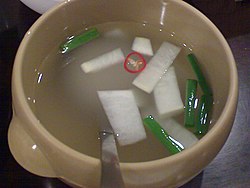Kimchi
Kimchi (Hangul: 김치; Korean pronunciation: [kimtɕʰi]; English: /ˈkɪmtʃi/), also spelled kimchee or gimchi, is a traditional fermented Korean side dish made of vegetables with many seasonings.[1][2][3] In traditional preparation, kimchi was stored underground in jars to keep cool during the summer months and unfrozen during the winter months.[4] There are hundreds of varieties of kimchi made from napa cabbage, radish, scallion, or cucumber as a main ingredient.[5]
Kimchi is usually very strong for non-Koreans. There are many different types and Koreans typically eat kimchi in every meal. It is a staple of Korean food. Kimchi can be stored for a long time and it does not go bad easily. However, when it is exposed to hot weather for certain time, kimchi turns sour. So, it should not be put out unless it is going to be eaten soon. In Korea kimchi pots are a common sight. They are large terra cotta pots where the kimchi is stored until it can be eaten or until it ferments. Kimchi usually takes about 2 weeks to ferment, but some varieties can be eaten right away. Some must be stored for over a year to be finished.
The fermentation gives the kimchi a pickle-like quality and generally soggy or limp kimchi is not good.
Varieties
Every different kind of kimchi has a special taste and a different amount of time to ferment. Baechu Kimchi is one of the most famous kimchi. Kkakdugi is made of cubed Korean radish (mu). It’s especially contains more water and is hard to chew. Baek kimchi uses milder ingredients. It’s not spicy. Chonggak kimchi has a smallish white radish that comes with a ponytail. Gat kimchi is made from dark green Korean mustard (gat) leaves and stems. These can be kept for months or even longer. As these age, they taste like lemons. Oi Sobagi has a refreshing, cool, and hot taste. Cucumber is the main ingredient for it. It can be kept for about a week. As it ages, it also taste like a lemon. Dongchimi is a food and a beverage all in one. When it ferments, it becomes sweet and taste a lot like lemon water. It can be kept for about a month.
Preparation
The most common variety of kimchi is made from cabbage, radish, garlic, red pepper, salt and sugar. The cabbage is soaked in salt water for a few hours. Coarse rock salt is then rubbed in between the leaves of the cabbage. Red peppers are also rubbed in and most Kimchi has a lot of pepper in it.[6] The radish is usually cut into long thin strips and added to the mix. A little sugar is added to help the fermentation process along much in the same way beer is made.[7] The amounts of each ingredient vary between the type of kimchi you are making and the personal taste of the maker. Most kimchi has a special taste with shrimp or fish.[8] The kimchi is allowed to ferment for a period of time, usually outdoors in a large kimchi pot. It is also quite common for these pots to be buried under ground. Kimchi can be kept for a long time and does not go bad. Koreans make kimchi with their families in December.[9]
Kimchi Media
Proclamation signed by Governor of Maryland Larry Hogan declaring 22 November as 'Kimchi Day' (2022)
Tongkimchi, gulgimchi (kimchi with additional oyster) and other banchan
Kimchi-buchimgae, a savory Korean pancake with kimchi
Dongchimi (동치미) is largely served during winter. Dongchimi is also used to make buckwheat naengmyeon, a popular dish during hot months.
Yeolmu-kimchi, cold, watery kimchi that is usually eaten with oily foods, is consumed mostly in the summer.
Kimchi jjigae (김치찌개), a stew made of kimchi, vegetables, broth, and other ingredients, is a popular dish during the cold months.
References
- ↑ kimchi. Encyclopædia Britannica.
- ↑ Kim, M.; Chun, J. (2005). "Bacterial Community Structure in Kimchi, a Korean Vegetable Food, as Revealed by 16S rRNA Gene Analysis". International Journal of Food Microbiology. 103 (1): 91–96. doi:10.1016/j.ijfoodmicro.2004.11.030. PMID 16084269.
- ↑ Chin, Mei (14 October 2009). "The Art of Kimchi". Saveur. Retrieved 9 August 2010.
- ↑ "Kimchi & National Security". Archived from the original on 11 April 2013. Retrieved 30 March 2013.
- ↑ "A World of Kimchi". SAVEUR.com. 14 October 2009. Retrieved 13 September 2014.
- ↑ "Kimchi - New World Encyclopedia". www.newworldencyclopedia.org. Retrieved 2017-05-19.
- ↑ (in en-US) Kimchi: A Short History - ZenKimchi. 2006-11-05. http://zenkimchi.com/top-posts/kimchi-1-short-history/. Retrieved 2017-05-19.
- ↑ (in en-US) 7 Different Kinds of Kimchi You Need to Try. 2011-11-14. https://www.10mag.com/seven-kinds-of-kimchi/. Retrieved 2017-05-19.
- ↑ (in en-US) The History of Kimchi -. 2015-02-24. http://thekoreancouponer.com/history-of-kimchi/. Retrieved 2017-05-19.










